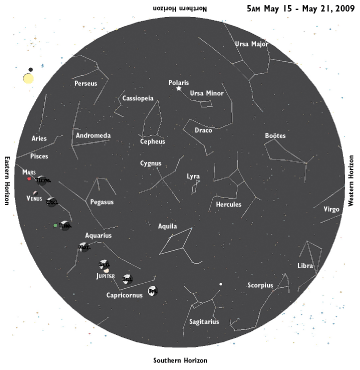
Volume XVII, Issue 20 # May 14 - May 20, 2009 |
 |
 |
Sky Watch
by J. Alex Knoll
A Marvelous Night for a
Moon Dance
You’ll have to be up early to catch this waning crescent and planetary followers
The waning moon rises after midnight this week and reaches last-quarter phase Sunday the 17th, when it travels through pre-dawn skies with Jupiter. Both rise in the east-southeast around 2am, with milky Jupiter less than three degrees to the south. As dawn approaches, they are high in the southeast. With sunrise at 6am, Jupiter winks from view, but the moon remains a ghost traveling westward through morning skies.
By Wednesday morning, the now-crescent moon rises after 3am, by which time Jupiter is already far to the south. But fast on the moon’s trail is brilliant Venus, which crests the east horizon around 4am, with Mars trailing behind another few degrees. Early Thursday in the pre-dawn glow around 4:30am, the slender moon, Venus and Mars appear low in the east, forming a near-equilateral triangle with only six degrees separating one from the other.
In the evening sky, Saturn reigns supreme, appearing high in the south at sunset, around 8:15 this week, and setting in the west around 3am. The ringed planet is brighter than any star and shines an unmistakable steady golden yellow. The next-brightest light comes from blue-white Regulus, the heart of Leo the lion, some 15 degrees to the west of Saturn.
The most familiar shape in the night sky, the Big Dipper, shines directly overhead at sunset. Three stars make up the Dipper’s handle, and the outmost two, Mizar and Alkaid, form a line that arcs eastward to the red-giant Arcturus, the fourth brightest star in the sky. From there, spike to the south to find golden Spica, the 16th brightest star.
Illustration: © Copyright 1925 M.C. Escher/Cordon Art-Baarn-Holland; Graphics: © Copyright 2009 Pacific Publishers. Reprinted by permission from the Tidelog graphic almanac. Bound copies of the annual Tidelog for Chesapeake Bay are $14.95 ppd. from Pacific Publishers, Box 480, Bolinas, CA 94924. Phone 415-868-2909. Weather affects tides. This information is believed to be reliable but no guarantee of accuracy is made by Bay Weekly or Pacific Publishers. The actual layout of Tidelog differs from that used in Bay Weekly. Tidelog graphics are repositioned to reflect Bay Weekly’s distribution cycle.Tides are based on National Oceanic and Atmospheric Administration and are positioned to coincide with high and low tides of Tidelog.
